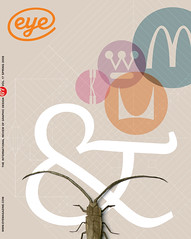Spring 2008
Trainspotting
Letter from Paul Shaw
Mary Ann Bolger’s ‘inner train-spotter’ must not have been functioning at full bore when she read Stephen Eskilson’s Graphic Design: A New History (Eye no. 66 vol. 17). Her two examples of mistakes are only the tip of the iceberg as the book is riddled with errors. I counted nineteen (misattributions, discrepancies between text and captions, misspellings of names, inaccurate dates) in the first 60 pages alone – sufficient to show that the book is much more flawed than Bolger indicates in her review. Eskilson may be good at discussing art history – those certainly are the parts I enjoyed the most – but he is abysmal at discussing type and typography.
Other aspects of Eskilson’s book are troubling, but I will cite only one, since it is mentioned approvingly by Bolger. It is his statement that the graphic design profession was established ‘when the task of designing printed material was separated from the task of printing it’. At first glance this seems like a reasonable claim, but he provides no support for it. Not only does he fail to mention individuals such as William Pickering, Bruce Rogers and Charles Ricketts who did indeed separate the activities of design and printing, but he also ignores the Nuremberg Chronicle (1493), a book that was clearly designed – a complete maquette survives – before it was printed. Finally, Eskilson makes no reference to W. A. Dwiggins, the man thought to have first coined the term ‘graphic design’. In other words, he never fully comes to grips with a definition of graphic design.
Paul Shaw, New York
---
Mary Ann Bolger replies: I am pleased that Paul Shaw has drawn attention to the typographic inaccuracies in Stephen J. Eskilson’s A New History of Graphic Design. As I pointed out in the review, the catalogue of errors in this book extends beyond the discussion of typographic matters and is evident throughout the text and in the captions.
A more pressing issue to consider is how and why we write about graphic design history. The book has provoked some heated debate on Design Observer.
With regard to Shaw’s final point, I agree that Eskilson fails to support his contention that graphic design as a profession, rather than an activity, is a product of industrialisation. This does not alter the fact that this could be a valid observation, and one that in other writing – by Richard Hollis, for example – has been better supported. The question of how to define graphic design in terms of practice as well as history is a timely one, worthy of a more detailed consideration and of interest to non-trainspotters, too!
First published in Eye no. 67 vol. 17 2008
Eye is the world’s most beautiful and collectable graphic design journal, published quarterly for professional designers, students and anyone interested in critical, informed writing about graphic design and visual culture. It is available from all good design bookshops and online at the Eye shop, where you can buy subscriptions and single issues.

